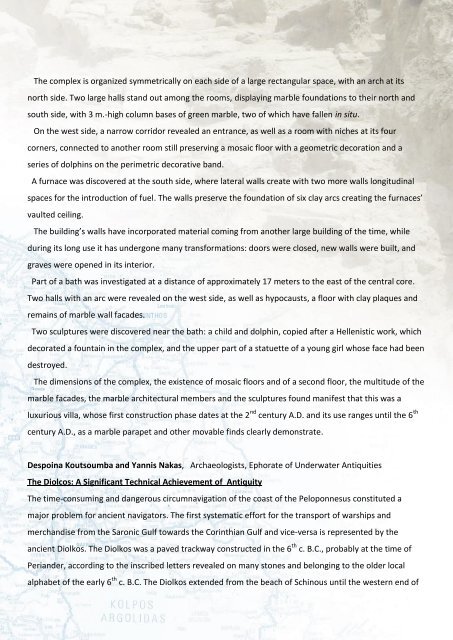ABSTRACTS - The American School of Classical Studies at Athens
ABSTRACTS - The American School of Classical Studies at Athens
ABSTRACTS - The American School of Classical Studies at Athens
You also want an ePaper? Increase the reach of your titles
YUMPU automatically turns print PDFs into web optimized ePapers that Google loves.
<strong>The</strong> complex is organized symmetrically on each side <strong>of</strong> a large rectangular space, with an arch <strong>at</strong> its<br />
north side. Two large halls stand out among the rooms, displaying marble found<strong>at</strong>ions to their north and<br />
south side, with 3 m.-high column bases <strong>of</strong> green marble, two <strong>of</strong> which have fallen in situ.<br />
On the west side, a narrow corridor revealed an entrance, as well as a room with niches <strong>at</strong> its four<br />
corners, connected to another room still preserving a mosaic floor with a geometric decor<strong>at</strong>ion and a<br />
series <strong>of</strong> dolphins on the perimetric decor<strong>at</strong>ive band.<br />
A furnace was discovered <strong>at</strong> the south side, where l<strong>at</strong>eral walls cre<strong>at</strong>e with two more walls longitudinal<br />
spaces for the introduction <strong>of</strong> fuel. <strong>The</strong> walls preserve the found<strong>at</strong>ion <strong>of</strong> six clay arcs cre<strong>at</strong>ing the furnaces’<br />
vaulted ceiling.<br />
<strong>The</strong> building’s walls have incorpor<strong>at</strong>ed m<strong>at</strong>erial coming from another large building <strong>of</strong> the time, while<br />
during its long use it has undergone many transform<strong>at</strong>ions: doors were closed, new walls were built, and<br />
graves were opened in its interior.<br />
Part <strong>of</strong> a b<strong>at</strong>h was investig<strong>at</strong>ed <strong>at</strong> a distance <strong>of</strong> approxim<strong>at</strong>ely 17 meters to the east <strong>of</strong> the central core.<br />
Two halls with an arc were revealed on the west side, as well as hypocausts, a floor with clay plaques and<br />
remains <strong>of</strong> marble wall facades.<br />
Two sculptures were discovered near the b<strong>at</strong>h: a child and dolphin, copied after a Hellenistic work, which<br />
decor<strong>at</strong>ed a fountain in the complex, and the upper part <strong>of</strong> a st<strong>at</strong>uette <strong>of</strong> a young girl whose face had been<br />
destroyed.<br />
<strong>The</strong> dimensions <strong>of</strong> the complex, the existence <strong>of</strong> mosaic floors and <strong>of</strong> a second floor, the multitude <strong>of</strong> the<br />
marble facades, the marble architectural members and the sculptures found manifest th<strong>at</strong> this was a<br />
luxurious villa, whose first construction phase d<strong>at</strong>es <strong>at</strong> the 2 nd century A.D. and its use ranges until the 6 th<br />
century A.D., as a marble parapet and other movable finds clearly demonstr<strong>at</strong>e.<br />
Despoina Koutsoumba and Yannis Nakas, Archaeologists, Ephor<strong>at</strong>e <strong>of</strong> Underw<strong>at</strong>er Antiquities<br />
<strong>The</strong> Diolcos: A Significant Technical Achievement <strong>of</strong> Antiquity<br />
<strong>The</strong> time-consuming and dangerous circumnavig<strong>at</strong>ion <strong>of</strong> the coast <strong>of</strong> the Peloponnesus constituted a<br />
major problem for ancient navig<strong>at</strong>ors. <strong>The</strong> first system<strong>at</strong>ic effort for the transport <strong>of</strong> warships and<br />
merchandise from the Saronic Gulf towards the Corinthian Gulf and vice-versa is represented by the<br />
ancient Diolkos. <strong>The</strong> Diolkos was a paved trackway constructed in the 6 th c. B.C., probably <strong>at</strong> the time <strong>of</strong><br />
Periander, according to the inscribed letters revealed on many stones and belonging to the older local<br />
alphabet <strong>of</strong> the early 6 th c. B.C. <strong>The</strong> Diolkos extended from the beach <strong>of</strong> Schinous until the western end <strong>of</strong>

















